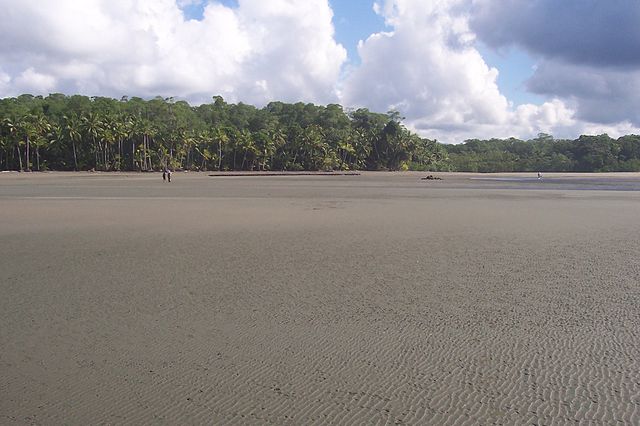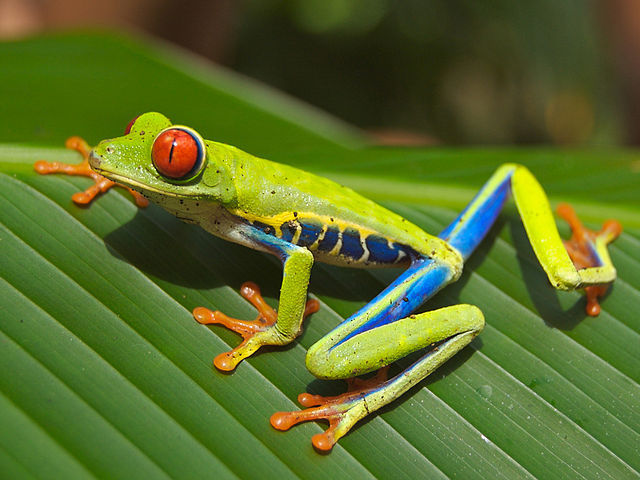
Tortuguero National Park
Tortuguero was founded in 1975 to protect endangered sea turtles. Even getting to this park is an adventure, requiring several hours by boat through the 150-kilometer-long system of natural canals known as Los Canales de Tortuguero. The network is composed of lagoons and natural canals that have for centuries provided the only possibility for transportation in this swampy area. The canals were used for the transportation of travelers and were the only means available to planters of getting bananas from their plantations to the markets. Most of the way the boats slide silently through thick carpets of blue flowering water hyacinths, while swarms of yellow and orange colored butterflies flutter above the water.
At the end of the 1960s, the Costa Rican government had four new canals built in order to connect the existing system of natural canals and lagoons into a navigable network of water highways for the northeastern lowland region.
The powerful earthquake that hit Costa Rica in April 1991 brutally rearranged this fine system of waterways and destroyed parts of it. It is still possible, however, to travel back and forth on canals between Siquirres, the Rio Pacuare and Moin, Tortuguero and the Rio Colorado, the Rio San Juan, Pavas and Puerto Viejo de Sarapiqui. The canals between Moin and Tortuguero are the most heavily used. Countless small and large motorboats ply this stretch in both directions. The leisurely boat trip on the Tortuguero-Moin canal lasts about three hours. The rotting piles of tumble-down buts appear again and again on the shores. The people who live in them scrape a meager existence out of their corn fields, and fish for tarpon and gar in the waterways. Their 10-meter-long canoes or dugouts are no match for the larger and faster motorboats that ply the waterway. Often the canoes are sent wildly rocking in the wake of a motorboat, and far too often the pile of coconuts on their way to market are sent tumbling into the water.
Travelers enjoy the refreshing wind and try to find a bit of shade from the merciless sun. After a trip of several hours they arrive at the village of Tortuguero.
The Turtle Experience
The Tortuguero National Park is unique in the world. Only eight kinds of sea turtles are known to exist on our planet, and six of these species lay their eggs on Costa Rican beaches; four of them come to Tortuguero. Since the 1950s, the egg-laying process of these endangered species of turtles has been observed and protected in this park.
The turtle population has slightly increased since then. Most visitors come to witness a turtle laying eggs, which, along with the boat trip along the canals, is reason enough to come to this 19,000-hectare park with its 5,000 to 6,000 mm of average annual rainfall.
The rangers and researchers in the park allow visitors to watch the turtles lay their eggs, and later to observe the new hatchlings as they see the first light of day – in any case always from a distance calculated not to disturb the great sea creatures. Visitors who want to take photographs should not use their flash. The newly-hatched turtles orient themselves to the light of the sun or moon, and the flash from a camera or flashlight can seriously confuse them. Those who want to test this should only do so by shining the light over the water, but even so, bright flashlights can irritate the baby turtles.
In order to observe all the different kinds of turtles that come to Tortuguero, you would have to spend virtually the entire year in the park. Leatherback turtles crawl up on the beaches between February and July. The 3,000 green sea turtles that visit the park each year arrive between July and October. During the same months the rarer loggerhead turtle also appears. Single turtles may show up throughout the year.
The easiest to observe is the green sea turtle. Costa Rica has three beaches where sea turtles still regularly come to lay their eggs. Two of them are on the Pacific coast (one of which is in Santa Rosa) and one is on the Caribbean in Tortuguero National Park.
Five species of sea turtle are known in Costa Rica: the leatherback, the bastard, the green sea turtle, the hawksbill and the loggerhead turtle. These living fossils (their family tree goes back 200 million years) show up on Costa Rican beaches twice a year: in April and between October and December. They come ashore when the tide is exactly right, on nights when the moon is full. The dig themselves a pit in the sand and lay up to 100 eggs in a single night before swimming back out to sea.
The heat of the sun beating down on the eggs under the sand incubates them, and two months later the young turtles hatch and try, as quickly as possible, to reach the safety of the sea before being picked off by hungry vultures circling above the beach. Those that survive remain at sea, swimming thousands of miles, and only see land again when they reach maturity.
The females return after seven years to their birthplace to lay their first eggs. Females ready to lay eggs wait in a protected spot near the shore until the moon is full and the tide is high, so that they only have a few meters to crawl onto the shore, where they make their nest above the tide line.
In the morning they have to return to the sea, despite their weakened state. Those that remain will dry out in the merciless heat of the sun or succumb, despite their hard shells, to the insistent attacks of vultures. Fully grown the turtles weigh hundreds of pounds and reach up to 1.5 meters in length, and 70 to 80 centimeters in breadth. The animals leave a very specific trail in the sand. It differs from species to species, and even laymen can easily learn to identify them in this way.
Green sea turtles can lay eggs up to seven times in one season, but usually limit themselves to two or three times. They only lay their eggs every three years, and always on the same beach.
Green sea turtles do not enjoy a particularly carefree existence. One of their worst enemies is the vulture, which seems intent on pecking away at the giant animals. Vultures especially like to attack female turtles on their way back to the protection of the sea in a weakened state from the strenuous process of scooping out their nest in the sand and laying eggs.
Nor do the freshly-hatched baby turtles come off much better. The vultures first snap off their heads and only return to their stored up booty when they find no more living turtles. Most of those that survive the harrowing race to the sea will fall victim to sharks and other sea creatures. Only a very small number – perhaps a mere one percent of the hatchlings
– survive the first months of their lives and live to maturity. Sometimes the male turtles come ashore to defend the females against the attacks of the vultures.
The worst enemy of the sea turtle, however, is man – worse than the vultures and the sharks together. Even today, despite conservation efforts, turtle poachers are as active as they ever were. Shells of bastard turtles and the tender meat of green sea turtles bring high prices on the black market. Huge sums of money are paid even for the eggs, which are eaten raw and are believed to improve sexual potency (for which there is still no scientific proof). The only thing that interests black-market operators, however, is making a quick profit.
Turtles are the most fascinating animals in Tortuguero National Park, and have justly lent their name to this great place. But many other animals fly and crawl in the park, as well. The long beaches are not all that merit attention.Excursions along the rivers and into the forests reveal an amazing array of mammals, birds, amphibians and reptiles, which alone would merit a visit to Tortuguero. Howler, capuchin and spider monkeys, along with sloths, anteaters, raccoons and kinkajous, enliven the upper canopy of the rain forest with their presence. Down below, peccaries and tapirs snort along the forest floor, and jaguars and ocelots stalk the thickest parts of the forest. From a boat you can explore the rivers and observe freshwater turtles warming themselves in the sun, basilisk lizards with their high comb, caimans, crocodiles and dozens of snakes (among them, for example, the poisonous fer-de-lance viper) and red-black poison arrow frogs.
The sky is full of birds. More than 300 different types, including many migrating birds from the United States and Canada, are to be found here. The easiest to spot are the different kinds of herons, plovers, sandpipers, egrets, royal terns, kingfishers and jacanas. Hummingbirds flit through the forest, along with rarely seen manakins, such as the golden manakin. Visitors who want to return the quickest way possible to San Jose also have to take to the air.




